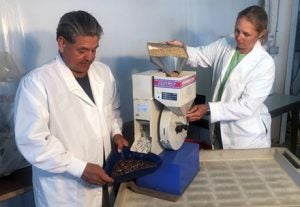Newly-developed purple and red rice varieties are adding a nutritional punch to the traditional staple. In addition to being relatively pretty, the new grains are offering farmers and soon, consumers an additional option to grains.
Anna McClung, research geneticist at the Dale Bumpers National Rice Research Center in Stuttgart, Arkansas, developed the pigmented purple and red varieties to enable American farmers to enter an important market.
McClung says that Americans can buy colored rice varieties, but the supply is predominantly from overseas.
“This is an opportunity for our domestic growers to have access to that market, which has greater economic potential than white milled rice,” she said.

The purple rice variety has been named USDA-Tiara. With conventional rice, the bran is removed during the milling process, leaving mostly the starchy outside of the grain behind. In these pigmented varieties, the bran contains vitamin E, fiber, and other vitamins.
“The pigments that are purple and red are just like the pigments that you find in grapes and berries and different fruits and vegetables, and some of those compounds — tannins, flavonoids, and phenolics — have been shown to have antioxidant properties, which have a potential health-beneficial effect,” McClung said.
While original strains of purple rice came from China, the varieties have been improved through careful breeding. McClung has worked over the last 15 years to develop an improved version of a strain that was adapted and developed in Brazil.
The red rice, which McClung also bred and named “Scarlett,” is the first red rice ever bred for commercial production in the United States. In the past, growers hesitated to grow red rice because it was regarded as a weed, with milled red grains causing rice to look “dirty” to consumers. While not native, the red rice had run wild and often inter-mingled with cultivated varieties, decreasing farmers’ net profit when the mixed rice was sold.
McClung was curious whether this disdained rice might have something to offer, and set out to answer the question, “Do these weedy rice varieties, which have ancestral lineage in common with regular cultivated rice, possess some good genes — genes that, through years of selection to make milled rice look pretty to consumers, have accidentally been thrown away? Are there interesting genes there that could help our existing crop, and could we move those back into our current cultivars?”
The answer was yes. “We found that the weedy species had yield-enhancing genes that we’d lost somewhere along the way,” McClung said.
Relative to conventional varieties, “the flavor and aroma expression is infinitely more readable, more attractive, and certainly more relevant,” said farmer Glenn Roberts, who grows the rice as part of his Anson Mills operation. “You can taste the difference.”
“My view is that as climate change advances, we’re going to be looking for more plant-based culinary options in general,” Roberts said. “In an increased plant-based environment, you want a rice that’s fast in and out of the field, that will stand well, that’s unique, and that is absolutely high-yielding. Anna’s put out two rices that yield like a bandit, they’re quick in and out of the field, and they have unique culinary properties.”


